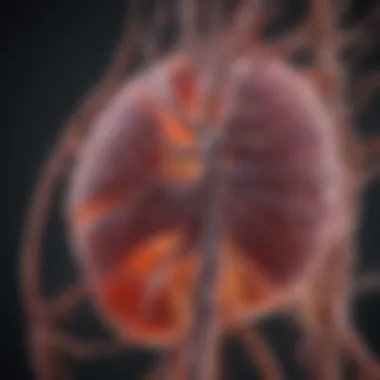Factors Influencing Liver Enzymes: An In-Depth Analysis


Overview of Research Topic
Brief Background and Context
Liver enzymes play crucial roles in various biochemical processes in the body. They are indicators of liver health and overall metabolic function. Elevated levels of these enzymes can reflect underlying health issues, prompting further investigation. The most commonly measured liver enzymes include alanine aminotransferase (ALT), aspartate aminotransferase (AST), alkaline phosphatase (ALP), and gamma-glutamyl transferase (GGT). Each of these enzymes can signal different forms of liver damage or dysfunction. Factors influencing their levels can vary widely, from genetics to lifestyle choices such as diet and exercise.
Importance in Current Scientific Landscape
Understanding the factors that affect liver enzyme levels is vital in the context of modern medicine. Increased liver enzymes can indicate liver diseases, including fatty liver disease, hepatitis, and cirrhosis. In recent years, research has connected lifestyle factors, environmental influences, and genetic predispositions to liver health. There is a growing body of evidence that stresses the importance of regular monitoring of liver enzyme levels for early disease detection and intervention. This knowledge empowers both healthcare professionals and the informed public, fostering better health outcomes.
Methodology
Research Design and Approach
This analysis draws upon recent studies examining the diverse factors influencing liver enzymes. A systematic literature review was conducted, focusing on peer-reviewed journals, clinical studies, and meta-analyses that explore biochemical, genetic, and lifestyle factors affecting liver health. The analysis integrates multifactorial approaches, examining how these factors collectively influence liver enzyme levels.
Data Collection Techniques
Data collection involved a thorough review of available research articles and clinical guidelines. Key resources included trusted medical journals and databases. Moreover, observational studies provided insights into how lifestyle choices, such as alcohol consumption, diet, and physical activity, relate to liver enzyme variances. The synthesis of this information allowed for a comprehensive understanding of the biomechanisms at play.
"Regular monitoring of liver enzymes is essential for prevention and early intervention in liver diseases."
By analyzing these dimensions, the research underscores the necessity for an integrated view of liver health that encompasses both biological and lifestyle factors.
Preface to Liver Enzymes
Liver enzymes play a critical role in evaluating liver health and function. Understanding liver enzymes is essential for both healthcare professionals and individuals interested in their overall well-being. Elevated levels of these enzymes can indicate underlying health issues. This knowledge becomes particularly vital when considering the liver's importance in various metabolic processes and its role as a detoxifying organ.
The primary liver enzymes of interest in clinical practice are alanine aminotransferase (ALT) and aspartate aminotransferase (AST). Their presence in the bloodstream typically reflects liver activity. When the liver is damaged or inflamed, these enzymes are released into the blood, leading to elevated levels. Monitoring these enzymes can provide essential insights into liver conditions, including hepatitis, fatty liver disease, and cirrhosis.
It is also important to consider lifestyle factors that can influence liver enzyme levels. Factors such as diet, exercise, alcohol intake, and medications all play a role in liver enzyme activity. An increased understanding of these influences can empower individuals to make informed health choices that benefit their liver function.
"A proactive approach to liver health includes regular monitoring of liver enzymes, which can help in early detection and management of potential issues."
Moreover, familiarity with these enzymes can guide healthcare professionals in diagnosing conditions and determining appropriate treatment strategies. For patients, knowing how personal habits affect liver enzymes can encourage lifestyle changes that promote liver health. Thus, being aware of what liver enzymes signify and their implications could lead to improved health outcomes for many.
Understanding Liver Function
The liver is a vital organ that plays a crucial role in various metabolic processes within the human body. Understanding its function is essential for recognizing the factors that might influence liver enzymes. Elevated liver enzymes can indicate dysfunction and are often the first sign of potential liver disease. A comprehensive grasp of the liver's roles provides insight into how lifestyle choices and certain conditions may lead to alterations in enzyme levels.
Role of the Liver in Metabolism
The liver serves as the primary metabolic hub for the body. It integrates carbohydrate, fat, and protein metabolism. Here are some key functions it performs:
- Glucose Regulation: The liver helps maintain blood glucose levels by converting excess glucose into glycogen for storage and releasing it when needed.
- Lipid Metabolism: It is involved in the synthesis and breakdown of fats. This process is necessary for energy production and storage.
- Protein Synthesis: The liver produces various proteins essential for blood clotting and maintaining oncotic pressure, among other functions.
- Detoxification: It helps detoxify harmful substances, including drugs and alcohol, making them easier for the kidneys to eliminate.
These metabolic functions underscore the liver’s importance to overall health. Disruption in any of these processes can lead to increased liver enzyme levels, signaling potential health issues.
Key Enzymes and Their Functions
Within the liver, various enzymes play critical roles in metabolic pathways. Here are a few of the most significant liver enzymes and their functions:
- Alanine Aminotransferase (ALT): Mainly found in the liver, ALT is essential for converting alanine and α-ketoglutarate into pyruvate and glutamate. Elevated levels usually suggest liver damage or inflammation.
- Aspartate Aminotransferase (AST): This enzyme is present in various tissues, including the liver, heart, and muscles. While AST levels can rise due to liver issues, they are not solely indicative of liver health as they can also reflect other organ conditions.
- Alkaline Phosphatase (ALP): Important for bile production, ALP is associated with bile duct function. Elevated levels may indicate blockages or liver disease.
- Gamma-Glutamyl Transferase (GGT): This enzyme is involved in the transfer of amino acids and peptides across cell membranes. It is often elevated in cases of alcohol abuse and bile duct obstruction.
The functions of these enzymes are fundamental in assessing liver health. Increased levels can mark injury or ongoing liver conditions, underlining the necessity for liver enzyme monitoring.
Common Causes of Increased Liver Enzymes
Understanding the common causes of increased liver enzymes is crucial for recognizing potential health issues. Elevated levels of liver enzymes can indicate liver injury or dysfunction. This section delves into specific elements that contribute to these elevations, helping readers appreciate the underlying health implications, potential risks, and considerations in management and prevention. Increased awareness can facilitate timely intervention, which can be pivotal in avoiding long-term damage and improving overall liver health.
Alcohol Consumption
Alcohol consumption is one of the most prevalent causes of elevated liver enzymes. Chronic and heavy drinking can lead to conditions such as fatty liver, alcoholic hepatitis, and eventually cirrhosis. Alcohol is metabolized in the liver, and excessive intake stresses the liver cells, leading to increased production of liver enzymes like AST and ALT.
Some important points regarding alcohol consumption include:
- Dose Dependence: The extent of liver enzyme elevation correlates directly with the amount of alcohol consumed. Heavy drinkers often show significant increases in liver enzymes.
- Liver Damage: Regular high consumption may induce inflammation and damage liver cells, resulting in elevated enzyme levels in the bloodstream.
- Severity of Impact: It is noteworthy that not all individuals who consume alcohol excessively will manifest elevated enzymes, as genetic factors and overall health can play a role.
Awareness of the impact of alcohol is essential for anyone who consumes it, as reducing intake can lead to improvements in liver health.
Obesity and Metabolic Syndrome


Obesity and metabolic syndrome are closely linked to liver enzyme abnormalities. This connection is primarily due to the development of non-alcoholic fatty liver disease (NAFLD), which is marked by the accumulation of fat in liver cells. Obesity not only elevates liver enzymes but also increases the risk of developing severe liver conditions.
Important aspects of this association include:
- Insulin Resistance: Obesity promotes insulin resistance, which has been shown to contribute to liver fat accumulation and, consequently, elevated liver enzymes.
- Inflammation: Increased fat in stomach area can lead to inflammation, further stressing the liver and resulting in higher enzyme levels.
- Components of Metabolic Syndrome: Conditions such as hypertension, dyslipidemia, and elevated blood sugar are often present in individuals with obesity, compounding the effects on liver health.
Managing weight through lifestyle changes is key in preventing the progression of liver disease related to obesity.
Viral Hepatitis
Viral hepatitis, caused by hepatitis viruses A, B, and C, is another major contributor to elevated liver enzymes. These viruses can lead to inflammation, and damaged liver cells release enzymes into the bloodstream. Chronic infections can cause persistent elevation of liver enzymes, which may progress to more severe liver disease.
Key points regarding viral hepatitis include:
- Transmission and Risk Factors: It is vital to understand routes of transmission, such as through blood exposure or unprotected sex, focusing on prevention measures, including vaccination for hepatitis A and B.
- Monitoring: Individuals with known viral hepatitis should have regular monitoring of liver enzymes to assess the extent of liver damage and the need for treatment.
- Chronic vs. Acute: Acute infections often result in a temporary increase in liver enzymes, while chronic infections may present ongoing elevations and complications.
Being informed about the risks associated with viral hepatitis contributes to better prevention and management strategies, leading to improved liver health.
Medications and Drug-Induced Liver Injury
Medications play a significant role in liver function and can lead to drug-induced liver injury (DILI). Understanding DILI is crucial for healthcare professionals and patients alike as it provides insight into how various medications impact liver enzymes. Elevated liver enzymes often indicate liver inflammation or damage, which can be a consequence of certain pharmaceuticals. The liver is responsible for metabolizing many substances, including drugs. This process can produce harmful metabolites that may lead to liver cell death and subsequent enzyme elevation.
Awareness of medications that can cause liver injury allows for better patient management and minimizes the risk of severe outcomes. For patients currently prescribed medication, monitoring liver enzyme levels becomes paramount. This proactive approach aids in identifying potential issues before they become serious or irreversible.
Common Offending Medications
Certain classes of drugs are more commonly associated with liver injury. Some notable examples include:
- Acetaminophen: Overdose is a leading cause of acute liver failure in many countries. Even at recommended doses, it can cause liver damage, especially in individuals with pre-existing liver disease.
- Antibiotics: Medications like amoxicillin-clavulanate and isoniazid have been documented to cause hepatotoxicity.
- Nonsteroidal Anti-Inflammatory Drugs (NSAIDs): While usually safe, there have been reports of liver enzyme elevations associated with long-term use of NSAIDs, such as ibuprofen and naproxen.
- Cholesterol-lowering agents: Statins have been linked to enzyme elevation in some cases, necessitating regular liver function tests during treatment.
"Awareness and caution regarding the use of medications are essential to prevent drug-induced liver injury."
Additionally, antiepileptics like phenytoin and valproate, and certain herbal supplements can also pose risks. Patients taking these medications should be counseled on potential symptoms of liver dysfunction, including jaundice, dark urine, abdominal pain, and fatigue.
Role of Herbal Supplements
Herbal supplements are often perceived as natural and harmless, yet they can also lead to elevated liver enzymes and liver damage. Many people believe that if something is herbal, it is safe. However, this assumption is misleading.
Common herbs linked to liver injury include:
- Kava: Known for its calming effects, kava has been connected to several cases of fulminant liver failure.
- Comfrey: Contains toxic alkaloids harmful to the liver. Its use has been banned in many countries.
- Green tea extract: While beneficial in moderation, concentrated extracts have been implicated in liver toxicity.
Patients should always inform their healthcare providers about any supplements they take. Certain supplements can interact with prescribed medications, amplifying risks for liver injury.
In summary, understanding the relationship between medications, herbal supplements, and liver health is essential. This knowledge supports informed decisions and encourages responsible use of both pharmaceuticals and natural products.
Autoimmune and Genetic Factors
The realm of liver enzymes includes complex interactions with autoimmune conditions and genetic anomalies. Autoimmune and genetic factors play a critical role in the function and health of the liver. Understanding these elements is essential in elucidating the reasons behind elevated liver enzyme levels.
These factors are significant because they can lead to persistent liver damage and other systemic effects if not identified and managed appropriately. Identification of autoimmune disorders or genetic deficiencies can guide therapeutic approaches and improve patient outcomes.
Autoimmune Hepatitis
Autoimmune hepatitis is a chronic condition where the immune system mistakenly attacks liver cells. In people with this disorder, the body produces antibodies that damage liver tissues, leading to inflammation. This inflammation can result in elevated levels of liver enzymes such as alanine aminotransferase (ALT) and aspartate aminotransferase (AST).
The exact cause of autoimmune hepatitis remains unclear. However, genetic predisposition and environmental triggers could potentially interplay to initiate the condition. Individuals with a family history of autoimmune diseases may be at a higher risk. Symptoms may include fatigue, jaundice, and abdominal discomfort. If untreated, autoimmune hepatitis can lead to cirrhosis and liver failure.
Key considerations in autoimmune hepatitis:
- Timely diagnosis is crucial for effective management.
- Immunosuppressive therapies are often employed to reduce immune activity.
- Regular monitoring of liver enzymes assists in assessing treatment response.
"Early detection and intervention in autoimmune liver diseases can significantly alter the disease trajectory and improve quality of life."
Genetic Deficiencies
Genetic factors can also influence liver enzyme levels through inherited metabolic disorders. Conditions such as Wilson's disease and hemochromatosis directly affect liver function and can lead to elevated liver enzymes.
Wilson's disease is caused by the accumulation of copper in the body due to impaired copper metabolism. The liver is unable to excrete excess copper, resulting in potential liver damage. Similarly, hemochromatosis involves excessive iron accumulation, which can cause irreversible liver scarring.
Identifying genetic deficiencies is critical for proper diagnosis and management. Genetic testing can uncover these conditions, allowing for preventative strategies and tailored treatment plans.


Considerations regarding genetic deficiencies:
- Genetic counseling may help family members understand their risks.
- Treatment often includes dietary modifications and medications to manage the excess metals in the body.
- Early intervention is key to prevent serious liver issues and maintain overall health.
Impact of Lifestyle Choices
The lifestyle choices individuals make play a critical role in health, particularly concerning liver enzyme levels. This section explores how various factors such as diet and physical activity significantly influence liver function. Understanding these aspects is vital for implementing effective strategies for maintaining liver health.
Dietary Influences
Diet profoundly affects liver function. Consuming a balanced diet rich in vitamins, minerals, and healthy fats can contribute to optimal liver enzyme levels. Conversely, diets high in processed foods, sugars, and unhealthy fats can lead to elevated liver enzymes. Nutrients such as omega-3 fatty acids, present in fish like salmon, have anti-inflammatory properties that can support liver health.
In practical terms:
- Fruits and Vegetables: A diet high in fruits and vegetables provides antioxidants, which protect liver cells from damage.
- Whole Grains: Foods like quinoa and brown rice are beneficial as they help in the metabolization of fats, thus reducing stress on the liver.
- Lean Proteins: Sources such as chicken or legumes assist in cellular repair in the liver.
Additionally, excessive intake of alcohol is a significant risk factor for liver damage. Reducing alcohol consumption can lower the risk of conditions such as fatty liver disease and hepatitis. > Moderate drinking is crucial; even small amounts can influence liver health.
Physical Activity and Sedentary Behavior
Exercise is another essential component impacting liver enzymes. Regular physical activity not only aids in weight management but also promotes the regulation of liver function. Studies show that sedentary behavior may lead to conditions like obesity, which is closely linked to fatty liver disease.
Engaging in at least 150 minutes of moderate exercise per week can yield substantial benefits. This includes activities like brisk walking, cycling, or swimming, which enhance overall metabolic health.
To summarize:
- Regular Exercise: This helps in reducing liver fat and improving enzyme levels.
- Sedentary Lifestyle: Prolonged periods of inactivity can lead to poor liver health and elevated enzymes.
- Balanced Routine: Incorporating short breaks to stand or move can mitigate risks associated with prolonged sitting.
In essence, both dietary choices and physical activity significantly influence liver enzyme levels. By cultivating positive habits, individuals can better protect their liver health and reduce the risk of associated diseases.
Diagnosis of Elevated Liver Enzymes
Diagnosing elevated liver enzymes is a critical step in understanding liver health and function. It allows healthcare professionals to identify potential liver damage or disease at an early stage. Elevated enzyme levels can serve as indicators for various health conditions, making them an essential focus in both clinical and research settings. They signify not only the presence of liver dysfunction but also help in monitoring responses to treatments and lifestyle changes.
Regular monitoring of liver enzymes is a crucial part of preventative healthcare. Identifying the root causes of enzyme elevation can lead to early intervention, potentially mitigating complications that arise from untreated liver conditions. This aspect is particularly valuable for at-risk populations, such as individuals with a history of alcohol use or those with metabolic syndrome. Failure to recognize elevated liver enzymes can result in significant health repercussions, emphasizing the need for appropriate diagnostic strategies.
Blood Tests and Their Interpretation
Blood tests are the primary method for diagnosing elevated liver enzymes. The commonly tested enzymes include alanine aminotransferase (ALT) and aspartate aminotransferase (AST). These enzymes are released into the bloodstream when liver cells are damaged.
Interpreting these enzyme levels requires a careful understanding of normal ranges and individual patient factors. For instance, elevated ALT levels are generally more indicative of liver cell injury, while elevated AST levels may not be as specific to liver damage.
- Normal ALT Range: Typically between 7 to 56 units per liter.
- Normal AST Range: Approximately 10 to 40 units per liter.
Elevated enzyme levels can be context dependent and should be interpreted along with clinical symptoms and overall health status.
Other blood tests may include alkaline phosphatase (ALP) and bilirubin levels. ALP can indicate bile duct obstruction or liver disease, while bilirubin levels give insights into liver processing ability and hemolysis.
A physician must consider these factors within the broader context of the patient’s history, medications, and any known risk factors for liver disease.
Imaging Techniques
Imaging techniques play an essential role in further diagnosing liver conditions after initial enzyme abnormalities are detected. Methods such as ultrasound, computed tomography (CT) scans, and magnetic resonance imaging (MRI) provide detailed images of the liver, revealing structural issues not visible through blood tests alone.
- Ultrasound: Often the first imaging technique employed due to its accessibility and lack of radiation. It can identify liver size, texture, and the presence of lesions or gallstones.
- CT Scans: Offer a more detailed view of the liver and surrounding structures, assisting in diagnosing tumors, abscesses, and other significant abnormalities.
- MRI: Provides high-resolution images and is particularly useful when assessing liver fat content and vascular structures.
In some cases, liver biopsy may be recommended to obtain tissue for histological analysis, especially when liver disease is suspected.
By integrating blood tests with imaging techniques, healthcare providers can arrive at a more accurate diagnosis, paving the way for appropriate management of elevated liver enzymes and associated conditions.
Consequences of Persistently Elevated Liver Enzymes
The examination of persistently elevated liver enzymes is crucial in understanding long-term health impacts. Often, increased levels are not merely an isolated anomaly. Instead, they reflect underlying issues that can lead to more serious medical conditions. Monitoring and addressing elevated liver enzymes is essential in preventing liver disease and maintaining overall health.
Potential for Liver Disease
When liver enzymes remain elevated over an extended period, there is a heightened risk of developing chronic liver diseases. Conditions like fatty liver disease, cirrhosis, and liver cancer can emerge as a direct consequence. Here are several key points to consider:
- Chronic Inflammation: Elevated enzymes are often indicators of liver inflammation. Continuous inflammation can damage liver tissue, leading to scarring or fibrosis.
- Non-Alcoholic Fatty Liver Disease (NAFLD): This condition, characterized by fat accumulation in the liver, can progress to steatohepatitis, which is linked to liver damage and is more severe.
- Cirrhosis: This advanced scarring of the liver results from chronic liver injury. It can severely impact liver function and may require interventions, including liver transplantation.
- Liver Cancer: Prolonged exposure to high liver enzymes is linked to various types of liver cancer. Regular monitoring becomes vital for early detection and intervention.
Understanding these potential outcomes emphasizes the necessity of proactive health measures when elevated liver enzymes are detected.


Systemic Impacts on Health
The liver plays a pivotal role in numerous physiological functions, including metabolism, detoxification, and immune response. Persistently elevated liver enzymes can disrupt these processes, contributing to systemic health issues. Consider the following impacts:
- Metabolic Disorders: Liver dysfunction can lead to insulin resistance, hypertension, and hyperlipidemia. These conditions may increase the risk of cardiovascular events.
- Immune Response Alteration: The liver is essential for the synthesis of proteins that are critical to an effective immune response. Impairment can lead to infections and increased susceptibility to diseases.
- Nutrient Absorption Issues: A compromised liver may affect bile production, impacting the digestion and absorption of essential nutrients. This can lead to deficiencies and associated health problems.
- Hormonal Imbalance: Since the liver metabolizes hormones, dysfunction may cause alterations in hormone levels, affecting various bodily systems, including reproductive health.
In summary, the consequences of persistently elevated liver enzymes go beyond the liver itself. They can influence many aspects of an individual’s health, making awareness and early intervention crucial.
"Monitoring liver enzymes is not just about liver health; it is about overall wellness and prevention of systemic disease."
Maintaining a comprehensive understanding of the consequences associated with elevated liver enzymes is paramount for health professionals and patients alike. It encourages timely interventions that can preserve liver function and prevent a cascade of health issues.
Treatment and Management Strategies
The treatment and management of elevated liver enzymes is a crucial aspect of healthcare, especially considering the potential implications associated with liver dysfunction. Elevated liver enzymes, markers of liver cell injury or inflammation, require a strategic approach to manage effectively. These strategies revolve around identifying the root causes and implementing targeted interventions that can help restore normal enzyme levels and improve overall liver function.
It is essential to adopt a multidimensional approach in managing liver health. This often includes lifestyle modifications as well as pharmacologic interventions. Both elements play a pivotal role in reversing liver damage and optimizing liver performance, ultimately aiding in the prevention of more severe liver diseases.
Lifestyle Modifications
Lifestyle modifications stand out as the first line of defense against elevated liver enzymes. These changes can significantly impact liver health and can be tailored to address individual risk factors. Following are some key modifications:
- Nutrition: A balanced diet is fundamental. Emphasizing fruits, vegetables, whole grains, and lean proteins can promote liver health. Diets high in sugar and saturated fats can worsen liver functions. Reducing processed foods contributes positively.
- Hydration: Keeping hydrated can assist the liver in detoxifying the body more efficiently. Drinking sufficient water supports liver function.
- Weight Management: Maintaining a healthy weight or losing weight if overweight is critical. Obesity can exacerbate liver enzyme elevations, particularly in non-alcoholic fatty liver disease.
- Regular Physical Activity: Engaging in regular exercise can improve metabolic health and reduce fat accumulation in the liver. It is beneficial to aim for at least 150 minutes of moderate aerobic activity each week.
"Lifestyle modifications not only help improve liver enzyme levels but also lead to overall health benefits."
Pharmacologic Interventions
Pharmacologic interventions may also be necessary when lifestyle modifications alone do not suffice. Medications can act directly on the liver or target underlying conditions contributing to elevated enzymes. Some notable approaches include:
- Antiviral Agents: For those with viral hepatitis, antiviral medications can reduce viral load and, consequently, liver inflammation. Drugs like tenofovir and entecavir are examples of efficacious antiviral agents.
- Antioxidants: Supplementation with antioxidants like vitamin E can improve liver health, particularly in individuals with non-alcoholic steatohepatitis (NASH).
- Cholesterol-Lowering Drugs: Statins can potentially benefit liver enzyme levels in individuals with elevated cholesterol and fatty liver disease.
- Insulin Sensitizers: Medications such as metformin can aid in managing insulin resistance, often seen in metabolic syndrome, which is linked to elevated liver enzyme levels.
In summary, both lifestyle modifications and pharmacologic interventions are critical in treating and managing elevated liver enzymes. Adopting these strategies can lead to improved liver health, prevention of disease progression, and enhanced overall well-being.
Future Directions in Liver Health Research
The exploration of liver enzyme levels serves as a crucial aspect in understanding liver health. Research in this area continues to evolve, revealing new insights about liver function, disease prevention, and management strategies. Focusing on future directions is essential as it highlights the ongoing need to improve diagnostic tools, deepen our knowledge of liver-related diseases, and enhance treatment options.
Emerging Therapies
Recent advancements in medicine have led to innovative treatment approaches for liver conditions related to elevated enzymes. Emerging therapies aim to target the underlying causes of liver dysfunction rather than just addressing symptoms. These novel treatments include gene therapy, which has the potential to correct specific genetic defects affecting liver function, and stem cell therapy, offering regenerative options for patients with severe liver damage.
- Gene Therapy: This technique involves altering the genes within a patient's liver cells to restore normal function. Early clinical trials show promise in treating genetic liver diseases like Alpha-1 Antitrypsin Deficiency.
- Stem Cell Therapy: Recent studies indicate that stem cells can differentiate into functioning liver cells. This approach could eventually lead to organ regeneration, thereby potentially reducing the need for liver transplants.
- Antiviral Treatments: For conditions like viral hepatitis, therapies have significantly advanced. Direct-acting antivirals are showing high cure rates and lower side effects than traditional treatments.
These emerging therapies could greatly impact patient outcomes. As research progresses, the understanding of how to optimize and apply these treatments effectively will also improve.
Potential Biomarkers
Identifying new biomarkers that can indicate liver health more accurately is another vital area of research. Current biomarkers, such as alanine aminotransferase (ALT) and aspartate aminotransferase (AST), are useful but may not always provide a complete picture of liver dysfunction.
- Non-invasive Biomarkers: Technologies like proteomics and genomics are being applied to discover non-invasive biomarkers that reflect liver inflammation and fibrosis. For instance, biomarkers such as FibroScan can help assess liver stiffness, indicating fibrosis without needing a biopsy.
- Metabolomic Profiles: Studies explore how metabolic profiles can serve as indicators of liver disease. By analyzing urine and blood samples, researchers aim to find specific metabolites linked with liver conditions.
- Genetic Markers: Genetic variations are being investigated for their potential roles in liver diseases. Identifying genetic markers can provide insights into an individual's susceptibility to liver conditions, enabling more personalized approaches to treatment and prevention.
The exploration of these potential biomarkers could revolutionize the monitoring and management of liver health. As testing methods become more accessible and accurate, healthcare providers can better diagnose and treat liver-related conditions, ultimately leading to a healthier population.
"The continuous advancement in therapies and biomarker discovery represents a promising frontier in liver health research."
As the integration of new knowledge and technologies takes place, the focus will remain on improving patient outcomes through better prevention strategies and management protocols.
Finale
In summary, understanding the factors influencing liver enzyme levels is crucial for both health professionals and individuals seeking to maintain optimal liver function. This article has presented a comprehensive exploration of the various elements contributing to elevated liver enzymes, including biochemical pathways, lifestyle choices, medications, and genetic factors.
Recognizing the significance of liver health can lead to early interventions that prevent the progression of liver disease. Elevated liver enzymes often serve as an early warning signal, indicating the need for further investigation and possible lifestyle modifications. Early detection allows for appropriate management strategies to be developed, which can significantly reduce the risk of severe health complications later on.
Key elements discussed include the impact of factors such as obesity, alcohol consumption, and certain medications on liver enzymes. These elements contribute to a broader understanding of how lifestyle choices can alter liver health, encouraging individuals to be proactive in making healthier decisions. Furthermore, advancements in research surrounding emerging therapies and potential biomarkers provide a sense of optimism for future treatment options.
The benefits of monitoring liver enzyme levels extend beyond just identifying potential health risks; it promotes a holistic view of one's health and encourages regular check-ups and blood tests. This proactive approach can lead to better management of existing conditions, and even reversibility in certain cases.
Overall, it is essential for individuals and healthcare providers to prioritize liver health through education, awareness, and routine monitoring. As we conclude, it is important to emphasize that maintaining a healthy liver is vital not only for liver function but also for overall systemic health. Engaging in healthy lifestyle behaviors can positively influence liver enzyme levels and promote long-term well-being.
Key Elements of References
- Credibility: Well-chosen references enhance the trustworthiness of an article by linking to recognized authorities in liver health and related research.
- Depth: By incorporating recent studies and clinical trials, the article provides a rich resource for readers. It goes beyond basic facts, offering insights from cutting-edge research.
- Further Reading: References act as a bridge, directing interested readers to more intricate discussions on biochemical pathways and treatment options. This can be particularly useful for students or professionals seeking deeper understanding.
- Contextual Evidence: Citing specific findings helps contextualize claims. For example, if discussing the impact of obesity on liver enzymes, referencing statistical data from studies can highlight the scale of the problem.
Considerations in Selecting References
- Recency: The liver research field is continually evolving. Recent studies can offer updated insights and reflect current best practices in management and diagnosis.
- Diversity of Sources: Using a mix of studies, reviews, and guidelines ensures a comprehensive perspective. Articles from journals like Hepatology or The American Journal of Gastroenterology can be primary sources to consider.
- Peer-Review Status: Referencing peer-reviewed articles provides an impartial assessment of the research quality. This practice upholds the scientific rigor the article aims to maintain.
In summary, the careful selection and presentation of references significantly enhance the article's authority and utility. They not only lend support to the content but also empower readers to expand their knowledge base effectively. The importance of well-structured references cannot be overstated in an article aimed at educating students, researchers, and professionals alike.



